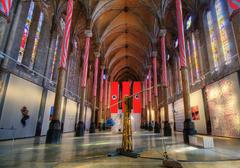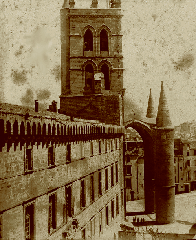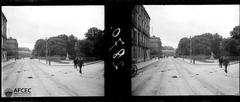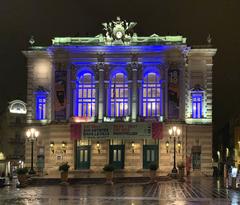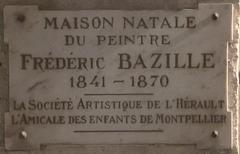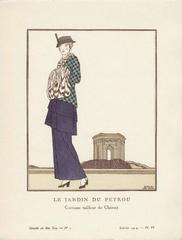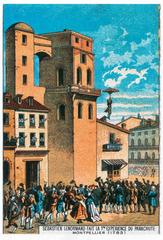Estorc Hotel Montpellier: Visiting Hours, Tickets, and Travel Guide
Date: 03/07/2025
Introduction to Hôtel Estorc, Montpellier
Located in the heart of Montpellier’s historic Écusson district, Hôtel Estorc is a striking testament to the city’s rich architectural and social history. Dating from the late 17th or early 18th century, this hôtel particulier embodies the elegance and ambition of Montpellier’s elite during the Ancien Régime. Its luminous limestone façades, ornate wrought-iron balustrades, and refined courtyards have been remarkably preserved, symbolizing the grandeur of the era. Although Hôtel Estorc is generally privately owned, its cultural significance is recognized through special guided tours and heritage events, which occasionally grant public access to its interiors.
The mansion’s central location makes it an ideal starting point for exploring Montpellier’s historic fabric. Notable nearby attractions include Place de la Comédie, Musée Fabre, and the Promenade du Peyrou—each easily accessible on foot thanks to Montpellier’s pedestrian-friendly old town and efficient transport links. However, visitors with mobility needs should review accessibility details in advance due to the heritage constraints of many historic buildings.
This guide provides thorough, up-to-date information on Hôtel Estorc’s visiting hours, ticketing, architectural highlights, and practical travel tips. Whether you are passionate about architecture, history, or immersive travel experiences, explore the splendor of Hôtel Estorc and discover Montpellier’s broader historical tapestry. For the latest information on visiting times and events, consult the Montpellier Tourist Office and Wikipedia’s list of Montpellier’s hôtels particuliers.
Table of Contents
- Origins and Architectural Context
- Historical Development and Ownership
- Architectural Features
- Cultural and Urban Significance
- Preservation and Contemporary Role
- Visiting Hôtel Estorc: Hours, Tickets, and Tips
- Location, Accessibility, and Nearby Attractions
- Special Focus: Promenade du Peyrou
- Summary and Final Tips
- Sources and Further Reading
Discover Hôtel Estorc: A Historical and Architectural Gem
Origins and Architectural Context
Hôtel Estorc is one of Montpellier’s esteemed hôtels particuliers—private city mansions commissioned by affluent merchants, magistrates, and nobility, mainly in the 17th and 18th centuries. These residences reflect the city’s prosperity and cultural ambitions during the Ancien Régime. Hôtel Estorc, with its classical proportions and refined details, stands as a prime example of this tradition (Wikipedia: Liste des hôtels particuliers de Montpellier).
Montpellier’s hôtels particuliers are recognized for their imposing facades, secluded courtyards, and grand staircases—features often concealed behind understated street entrances. Hôtel Estorc displays signature elements such as wrought-iron balconies and sunlit courtyards, encapsulating the city’s classical period (Montpellier Tourist Office).
Historical Development and Ownership
The precise construction date of Hôtel Estorc is not widely documented, but its architectural style indicates a late 17th- or early 18th-century origin. At this time, Montpellier flourished as a center of trade, administration, and learning. The Estorc family, notable members of the city’s bourgeoisie or nobility, owned the mansion, symbolizing their integration into Montpellier’s social and political elite.
Architectural Features
Though detailed surveys are limited, Hôtel Estorc likely includes:
- Grand Entrance Portal: Sculpted stone with family crests.
- Central Courtyard: Illuminated and private, serving as a social and architectural focal point.
- Monumental Staircase: Featuring intricate wrought-iron balustrades.
- Symmetrical Facades: Emphasizing classical harmony.
- Decorative Interiors: Stucco, painted ceilings, and period fireplaces (Wikimedia Commons: Hôtel Estorc).
These features align with the architectural trends of Montpellier’s hôtels particuliers and the social aspirations of their patrons.
Cultural and Urban Significance
Hôtel Estorc is one of nearly 80 preserved private mansions in Montpellier’s medieval core, the Écusson. The proliferation of such mansions mirrors the city’s rise as a commercial and political hub from the Middle Ages through the Enlightenment, attracting wealthy residents who invested in grand urban homes. The city’s legacy as the site of the world’s oldest medical faculty and a major law and commerce center is reflected in the architectural sophistication of its hôtels particuliers.
Preservation and Contemporary Role
Listed in the Base Mérimée national historic monuments database (Wikipedia: Liste des hôtels particuliers de Montpellier), Hôtel Estorc benefits from robust conservation efforts. Some hôtels particuliers have been adapted for cultural venues, offices, or luxury accommodations. While interior access to Hôtel Estorc is generally restricted, the Montpellier Tourist Office organizes occasional guided tours, providing rare insights into its architecture and history.
Visiting Hôtel Estorc: Hours, Tickets, and Tips
Visiting Hours and Tickets
- Interior Access: Usually available only during special guided tours or heritage events organized by the Montpellier Tourist Office.
- Booking: Advance reservations are highly recommended due to limited availability. Check the Montpellier Tourist Office for up-to-date schedules and ticketing details.
- Entrance Fees: Special event tours may require a ticket; prices and availability vary by event.
Location and Accessibility
- Address: 29 Rue de l’Aiguillerie, 34000 Montpellier, France (Monumentum).
- District: In the Écusson, Montpellier’s pedestrian-friendly old town.
- Accessibility: The entrance is generally at street level, but the building’s historic nature may limit accessibility for those with mobility needs. Contact the property or tourist office in advance for specific information (World Crutches).
Photography and Nearby Attractions
- Photography: Permitted in exterior areas and courtyards—ideal for those interested in classical architecture.
- Nearby Sights: Place de la Comédie, Musée Fabre, Arc de Triomphe, Promenade du Peyrou, and other historic mansions (France This Way).
Best Time to Visit
- Seasons: Spring and autumn are especially pleasant for exploring Montpellier’s historic core and participating in guided tours.
Practical Information: Getting There and Local Amenities
Transportation
- Tram: A five-minute walk from the nearest tram stop, connecting to all city lines (The South of France).
- Bus: Several bus routes serve the area.
- Train: Montpellier Saint-Roch station is 1 km away, with TGV connections to major French and European cities.
- Airport: Montpellier Méditerranée Airport is 11 km from the center, accessible by shuttle or taxi (Booking.com).
- Parking: Available in public car parks nearby due to pedestrianized old town streets.
Local Amenities
- Hotels: Various options in close proximity, including Hôtel des Frênes, Hôtel Kalliste, Grand Hôtel du Midi, Hôtel Royal, and Hôtel de La Comédie (Musée du Patrimoine).
- Dining: Numerous cafés and restaurants serve Languedoc specialties and international cuisine (The Crazy Tourist).
- Shopping: Independent boutiques and artisan shops line the surrounding streets.
Special Focus: Promenade du Peyrou
Overview
The Promenade du Peyrou is a grand esplanade atop a hill near Hôtel Estorc, featuring Montpellier’s Arc de Triomphe and the Château d’Eau. This open space, dating to the 17th century, is renowned for its panoramic views and historic monuments.
Visitor Information
- Opening Hours: Publicly accessible year-round, 24/7.
- Tickets: Free entry; guided tours may have separate fees.
- Accessibility: Wheelchair accessible, though some cobblestone paths may require assistance.
Highlights
- Arc de Triomphe: A 17th-century triumphal arch honoring Louis XIV.
- Scenic Views: Overlook the city, Mediterranean, and Cévennes mountains.
- Nearby Museums: Musée Fabre and Jardin des Plantes are close by.
Tips
- Visit in the early morning or late afternoon for cooler temperatures and fewer crowds.
- Comfortable shoes are recommended for the sloped, cobbled terrain.
Frequently Asked Questions (FAQ)
Q: Can I visit Hôtel Estorc year-round?
A: Interior access is usually limited to special guided tours or heritage events. The exterior can be viewed from the street at any time.
Q: How do I book a tour?
A: Reserve through the Montpellier Tourist Office website or in person; advance booking is recommended.
Q: Is Hôtel Estorc a functioning hotel?
A: No, it is a historic monument and does not provide guest accommodations.
Q: Is it wheelchair accessible?
A: Accessibility is limited due to heritage constraints. Contact the property or tourist office in advance for the latest details.
Q: What are some nearby attractions?
A: Place de la Comédie, Musée Fabre, Promenade du Peyrou, and numerous historic mansions are all within walking distance.
Summary and Final Tips
Hôtel Estorc is a jewel of Montpellier’s architectural heritage, offering rare insights into the city’s aristocratic past. While public access to the interiors is generally reserved for special events and tours, the building’s exterior and historic context make it a must-see for visitors exploring the Écusson district. Plan ahead for guided visits, and complement your experience with a walk through the nearby Promenade du Peyrou and other landmark sites. For the latest updates on visiting hours and events, check with the Montpellier Tourist Office and consult official heritage listings (Monumentum).
Enhance your cultural journey in Montpellier by using digital resources like the Audiala app, and immerse yourself in the vibrant history and architecture that define this remarkable city.
Sources and Further Reading
- Montpellier Tourist Office
- France Today: Montpellier Ambition and Architecture
- Monumentum: Hôtel Estorc Historical Listing
- World City Trail: Fun Facts About Montpellier
- Wikipedia: Liste des hôtels particuliers de Montpellier
- France This Way: Montpellier Guide
- The Crazy Tourist: Best Things to Do in Montpellier
- Musée du Patrimoine: Hôtel Estorc
- Booking.com: Montpellier Hotels
- World Crutches: Ultimate Guide to Hotel Accessibility
- The South of France: Montpellier History
For more travel tips and exclusive content on Montpellier’s historical sites, download the Audiala app and follow us on social media. Enrich your journey by exploring related guides on Montpellier’s Old Town and Musée Fabre.
